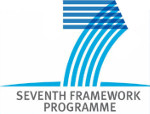Fast and simple assessment of surface contamination in operations involving nanomaterials
Clemente, A. ; Jiménez, R. ; Encabo, M.M. ; Lobera, M.P. (Universidad de Zaragoza) ; Balas, F. (Universidad de Zaragoza) ; Santamaria, J. (Universidad de Zaragoza)
Resumen: The deposition of airborne nanosized matter onto surfaces could pose a potential risk in occupational and environmental scenarios. The incorporation of fluorescent labels, namely fluorescein isotiocyanate (FITC) or tris-1, 3-phenanthroline ruthenium (II) chloride (Ru(phen)3Cl2), into spherical 80-nm silica nanoparticles allowed the detection after the illumination with LED light of suitable wavelength (365 or 405 nm respectively). Monodisperse nanoparticle aerosols from fluorescently labeled nanoparticles were produced under safe conditions using powder generators and the deposition was tested into different surfaces and filtering media. The contamination of gloves and work surfaces that was demonstrated by sampling and SEM analysis becomes immediately clear under laser or LED illumination. Furthermore, nanoparticle aerosols of about 105 nanoparticles/cm3 were alternatively fed through a glass pipe and personal protective masks to identify the presence of trapped nanoparticles under 405 nm or 365 nm LED light. This testing procedure allowed a fast and reliable estimation of the contamination of surfaces with nanosized matter, with a limit of detection based on the fluorescence emission of the accumulated solid nanoparticles of 40 ng of Ru(phen)3@SiO2 of silica per mg of non-fluorescent matter.
Idioma: Inglés
DOI: 10.1016/j.jhazmat.2018.10.011
Año: 2019
Publicado en: JOURNAL OF HAZARDOUS MATERIALS 363 (2019), 358-365
ISSN: 0304-3894
Factor impacto JCR: 9.038 (2019)
Categ. JCR: ENVIRONMENTAL SCIENCES rank: 8 / 265 = 0.03 (2019) - Q1 - T1
Categ. JCR: ENGINEERING, ENVIRONMENTAL rank: 4 / 53 = 0.075 (2019) - Q1 - T1
Factor impacto SCIMAGO: 2.01 - Environmental Chemistry (Q1) - Environmental Engineering (Q1) - Waste Management and Disposal (Q1) - Pollution (Q1) - Health, Toxicology and Mutagenesis (Q1)
Financiación: info:eu-repo/grantAgreement/ES/DGA/FSE
Financiación: info:eu-repo/grantAgreement/EC/FP7/263147/EU/Development of reference methods for hazard identification, risk assessment and LCA of engineered nanomaterials/NANOVALID
Financiación: info:eu-repo/grantAgreement/ES/MINECO/JCI-2012-13421
Financiación: info:eu-repo/grantAgreement/ES/MINECO/RYC-2011-07641
Tipo y forma: Artículo (PostPrint)
Área (Departamento): Área Ingeniería Química (Dpto. Ing.Quím.Tecnol.Med.Amb.)
 Derechos reservados por el editor de la revista
Derechos reservados por el editor de la revista
Exportado de SIDERAL (2020-07-16-08:53:55)
Visitas y descargas
Idioma: Inglés
DOI: 10.1016/j.jhazmat.2018.10.011
Año: 2019
Publicado en: JOURNAL OF HAZARDOUS MATERIALS 363 (2019), 358-365
ISSN: 0304-3894
Factor impacto JCR: 9.038 (2019)
Categ. JCR: ENVIRONMENTAL SCIENCES rank: 8 / 265 = 0.03 (2019) - Q1 - T1
Categ. JCR: ENGINEERING, ENVIRONMENTAL rank: 4 / 53 = 0.075 (2019) - Q1 - T1
Factor impacto SCIMAGO: 2.01 - Environmental Chemistry (Q1) - Environmental Engineering (Q1) - Waste Management and Disposal (Q1) - Pollution (Q1) - Health, Toxicology and Mutagenesis (Q1)
Financiación: info:eu-repo/grantAgreement/ES/DGA/FSE
Financiación: info:eu-repo/grantAgreement/EC/FP7/263147/EU/Development of reference methods for hazard identification, risk assessment and LCA of engineered nanomaterials/NANOVALID
Financiación: info:eu-repo/grantAgreement/ES/MINECO/JCI-2012-13421
Financiación: info:eu-repo/grantAgreement/ES/MINECO/RYC-2011-07641
Tipo y forma: Artículo (PostPrint)
Área (Departamento): Área Ingeniería Química (Dpto. Ing.Quím.Tecnol.Med.Amb.)
Exportado de SIDERAL (2020-07-16-08:53:55)
Enlace permanente:
Visitas y descargas
Este artículo se encuentra en las siguientes colecciones:
Artículos > Artículos por área > Ingeniería Química
Registro creado el 2019-10-25, última modificación el 2020-07-16
